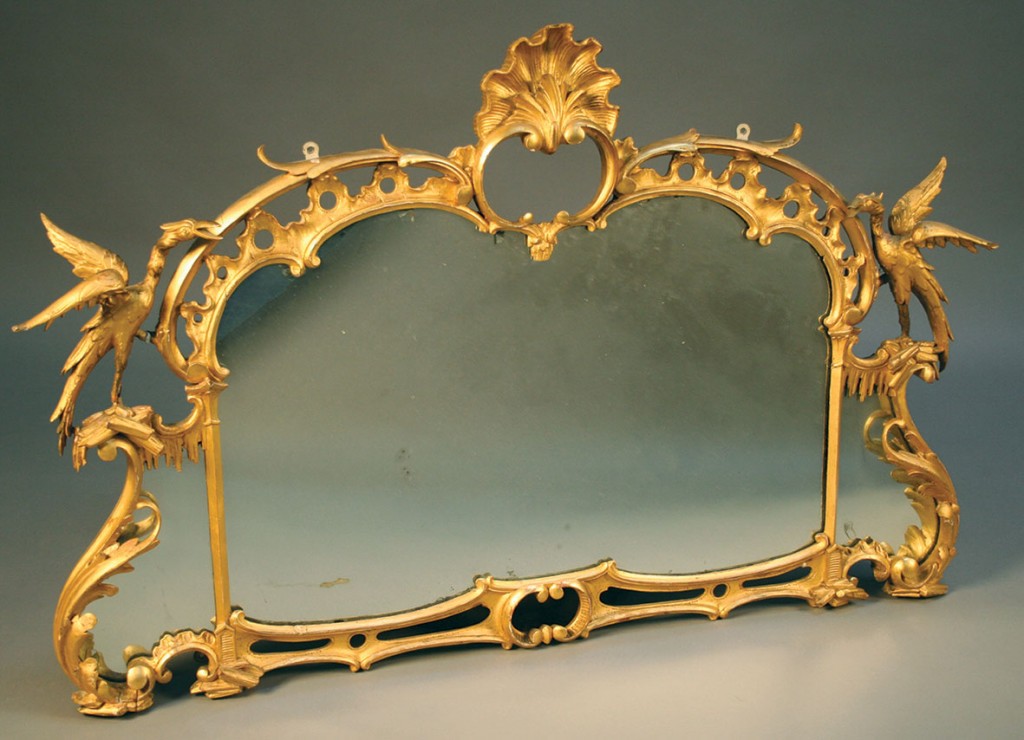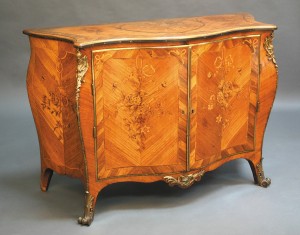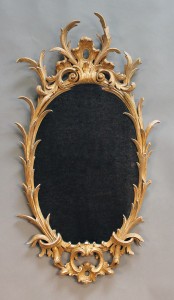
Fashion in our own times often seems to be driven in a reactionary way, as one style supplants another. It is perhaps surprising to reflect that this is not just a modern phenomenon. In early 18th century France the style which was to become known as ‘Rococo’ developed in reaction to the Baroque that preceded it. There is a playful quality to the Rococo. Here the classical gives way to decorative motifs drawn from nature and in England even the influences of Chinese and Gothic taste are sometimes incorporated.
The Edict of Nantes was passed by Henry IV of France in 1598 to bring to an end the French Wars of Religion, which had raged between Catholics and Protestants in the second half of the 16th century. It granted French Protestants, often known as Huguenots, far-reaching rights to work in all spheres of civil and state life. Although it brought a form of peace to France, Huguenots continued to face hostility and prejudice in what remained a predominantly Catholic country. The edict also had a weakening effect on the French monarchy. In 1685 Louis XIV, the Sun King, famous for his extravagant court at Versailles, revoked the Edict of Nantes and later sought to force Huguenots to convert to Catholicism. Huguenot craftsmen left France in large numbers, taking refuge in Protestant countries like England, Holland and Switzerland. In this country they had a profound effect on the life of our nation. For example, the first Governor of the Bank of England, Sir John Houblon, and several of his directors were of Huguenot origin. They also brought the influence of French tastes and styles.
It is difficult to determine where the weighty Renaissance Baroque of Louis XIV’s reign ends and the Rococo begins in France, as one grew out of the other. The term ‘Rococo’ is a 19th century creation, a combination of ‘rocaille’, referring to shellwork, and ‘barocco’, a term first used in a rather disparaging way to describe the outmoded Baroque style in the early 18th century. It was not until the 1940s that Rococo assumed its present association with this style.
In 1715 Louis XIV died, leaving his five-year-old great-grandson as heir to the French throne. He would later become Louis XV, when he had reached maturity. The French Regency under Philippe, the Duc d’Orléans, lasted until 1723. The Régence style marked a new phase in the development of the French Rococo and by the 1730s it had developed into the ‘genre pittoresque’, which saw rocky caves, dragons and waterfalls, embellished by shells, bocages and putti, employed in romantic compositions which delight in their playful and spirited designs. Major exponents included Nicolas Pineau (1684-1754) and Juste-Aurèle Meissonier (1695-1750).
By the reign of Queen Anne (1702-1714), England’s furniture-making industry had found its own and particular voice. By the 1720s in London, it was concentrated around St. Paul’s Churchyard and Palladianism was the predominant taste. Its restrained classical lines and proportions were inspired by the Venetian architect Andrea Palladio (1508-1580), who himself was influenced by Greek and Roman architecture from classical antiquity. Palladianism was expressed beautifully in this country by the extraordinary architect Inigo Jones (1573-1652). William Kent (1685-1748), under the patronage of Lord Burlington at Chiswick House and British Prime Minister Sir Robert Walpole at Holkham Hall in Norfolk, continued in the Palladian style. Indeed, Holkham Hall is perhaps Kent’s most complete expression of the Palladian taste and, to my eye, one of the finest houses in England. In 1735 William Hogarth founded the St. Martin’s Lane Academy in London. Influenced by the French Régence and in reaction to the restraint of Palladianism, the Academy was chiefly responsible for the promotion of the Rococo style in London. The importance of nature in ornament and the beauty of the serpentine line were inculcated in a generation of furniture makers by teachers like Louis-François Roubiliac. As the furniture-making industry in London gravitated towards St. Martin’s Lane from St. Paul’s Churchyard, it increasingly brought cabinetmakers into the sphere of influence of the Academy and the Rococo style was quickly assimilated. Anti-French sentiments in the mid-18th century led to an anglicising of the Rococo taste. The English Rococo taste is typified by its use of asymmetrical ‘C’ scrolls, cartouches and acanthus leaf foliage in combination with rockwork, animals and naturalistic trees. The George III Rococo giltwood and gesso-framed wall mirror illustrated, with its shell surmount, rockwork frieze, scrolls, foliage and fabulous birds, captures much of this taste. By the 1750s, both Chinese and Gothic influences had been added to the Rococo decorative vocabulary. The Gothic taste was popularised by Sir Robert Walpole’s son Horace and his famous Strawberry Hill Gothic villa, which he built at Twickenham between 1749 and 1776.

The influence of French taste is clearly evident in the early George III kingwood parquetry and marquetry commode illustrated, attributed to the celebrated French cabinetmaker Pierre Langlois. The commode is very similar to a pair of commodes commissioned by William Craven, 6th Baron Craven (1738-91) for Benham Park. The Craven commodes were attributed to Pierre Langlois, in association with the bronze-caster and gilder Dominique Jean, in a series of articles published in ‘Connoisseur’ magazine by Peter Thornton and William Reider, 1971-72. Pierre Langlois established himself as one of the leading cabinetmakers in London while trading from his premises at 39 Tottenham Court Road between 1759 and 1781. His clients included many important figures of the time, including the 4th Earl of Bedford for Woburn Abbey and Horace Walpole. The commode was banded in palisander, the top inlaid with ribbon-tied summer flowers within a stiff-leaf cartouche, flanked by two flower sprays. The sides and two doors were inlaid with swagged summer flowers, ribbon bows and moths, while the front projecting corners, apron and feet were decorated with ormolu shell and acanthus-leaf scroll mounts and sabots. The interior was fitted with three palisander-fronted drawers and Rococo-shell handles. The carcass and shaped apron were supported by outswept tapering bracket feet. The commode was auctioned at Toovey’s for £160,000.

In the October Specialist Furniture Auction Toovey’s offered a collection of fine 18th century English furniture, consigned for sale by The Royal College of Radiologists in London. Highlights includes a number of gilt-framed Rococo wall mirrors. The example illustrated sold within estimate for £1200.
For more information on Toovey’s specialist furniture sales click here.
By Revd. Rupert Toovey. Originally published on 9th October 2013 in the West Sussex Gazette.